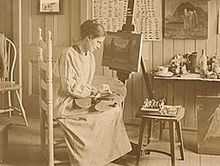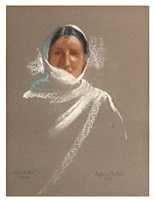Agnes Lawrence Pelton

Agnes Lawrence Pelton (1881–1961) was a modernist painter who was born in Germany and moved to the United States as a child. She studied art in the United States and Europe. She made portraits of Pueblo Indians, desert landscapes and still lifes. Pelton's work evolved through at least three distinct themes: her early "Imaginative Paintings", art of the American Southwest people and landscape, and abstract art that reflected her spiritual beliefs.
Early life
Agnes Lawrence Pelton was born in Stuttgart, Germany to American parents, William Halsey Pelton and Florence Pelton.[1] Her maternal grandfather was American abolitionist Theodore Tilton and her paternal grandfather was a plantation owner in Louisiana.[2] She lived in Rotterdam, the Netherlands from 1882 to 1884 and in Basel, Switzerland from 1884 to 1888.[1] Agnes and her mother moved to her mother's family hoe in Brooklyn after her father’s death in 1890 of a morphine overdose.[2] Florence Pelton studied music at the Stuttgart Conservatory of Music and operated the Pelton School of Music in Brooklyn for 30 years. She also gave lessons in French and German.[2][3] Due to her poor health, Agnes was educated at home and her mother and Arthur Whiting taught her piano.[3]
Education
Pelton studied at the Pratt Institute from 1895 to 1900,[1] graduating with fellow Modernist artist Max Weber.[2] She continued her studies with one of her instructors, Arthur Wesley Dow, in Ipswich, Massachusetts. She studied landscape and was Dow's assistant at his summer school, where he taught Modernism, inspired by Chinese and Japanese art. Biographer Tiska Blankenship said that "Dow emphasized structure, spirit, imagination, creation, and the nonnaturalistic use of color, a technique he taught using Japanese prints to demonstrate space relations and the appropriate use of light and dark masses... Dow's influence was critical to Pelton's development of abstractions based on interior, spiritual values."[3] Dow also taught Georgia O'Keeffe.[2] Pelton took summer classes from William Langson Lathrop in 1907. Pelton studied in Italy in 1910 and 1911, taking life drawing lessons and studying Italian painters at the British Academy in Rome, and also studied with Hamilton Easter Field,[1][3] who was another of her Pratt instructors.[3]
Career

Her work was exhibited in Ogunquit, Maine at Field's studio in 1912. Based upon her work at that show, Walt Kuhn invited her to participate in the 1913 Armory Show, where two of her paintings, Stone Age and Vine Wood were exhibited.[1][3] What Pelton called "Imaginative Paintings" were influenced by the work of Arthur B. Davies and depicted the effect of natural light. She made these paintings from 1911 to 1917.[2][3]

Pelton's work changed significantly following a visit to Mabel Dodge Luhan in Taos, New Mexico in 1919. She painted in oil and used pastels to create realistic portraits and desert landscapes and her works were exhibited in Santa Fe at the School of American Research.[3] Pelton visited Pueblo Indians in the American southwest.
Pelton had her studios in Greenwich Village[2] in New York City until 1921 when her mother died. She moved to Long Island and lived in a Hayground windmill that had been converted to a house. She also traveled to Hawaii, Beirut, Syria, Georgia and California.[3]
She painted portraits and still lifes in Hawaii in 1923 and 1924. She created abstract works of art beginning 1926, which were exhibited in New York at the Argent Galleries and the Museum of New Mexico. By 1926, she had exhibited in 20 group exhibitions and 14 solo exhibitions.[3]
She settled in Cathedral City, California in 1932.[3] Pelton originally intended to just visit the area, but lived there nearly 30 years. She wrote:
The vibration of this light, the spaciousness of these skies enthralled me. I knew there was a spirit in nature as in everything else, but here in the desert it was an especially bright spirit.[2]
Pelton recorded her spiritual and philosophical thoughts, had an "intense interest" in Agni Yoga, which influenced her work. Seven of her paintings, like Fires of Spring and White Fire, represented the fire symbol of Agni Yoga. She had a close friendship with modern transpersonal astrology pioneer Dane Rudhyar and Modernist Southwest painter Raymond Jonson.[3] In 1938, she was a co-founder, first president, and the oldest member of the Transcendental Painting Group.[2] Pelton died in Cathedral City in 1961 and was cremated.[3] Her ashes were buried in the San Jacinto Mountains.[4]
Posthumous exhibitions and legacy
"Agnes Pelton, Poet of Nature", a 1995-1996 retrospective exhibition of her work, brought national attention to her work.[3] Curator Michael Zakian wrote:
Pelton's works were poetic celebrations of nature that explored the vital forces animating the physical world. Interested in themes of creation, growth, and radiance, Pelton translated favorite subjects—a glowing star, an opening flower—into life-affirming images of rare beauty and resonance. In many ways, her paintings resemble the art of her contemporary Georgia O'Keeffe, only more colorful, more spiritual, and more imaginative.[2]
In 2009, her work was exhibited with three other Modernist artists: Georgia O'Keeffe, Florence Miller Pierce, and Agnes Martin. A 192 page catalog accompanied the exhibition.[5]
The Agnes Pelton Society was founded in 2013 to promote Pelton's life and legacy.[6]
Collections
- Honolulu Museum of Art, Hawaii
- The Raymond Jonson Collection, University of New Mexico Art Museum, Albuquerque
- Oakland Museum of California
- Palm Springs Art Museum, California
- Parrish Art Museum, Southampton, New York
- San Diego Museum of Art, California: The Primal Wing, 1933[7]
- Santa Barbara Museum of Art, California
- New Mexico Museum of Art[8]
- Whitney Museum of American Art, New York: Untitled abstract, 1931[9]
References
- ↑ 1.0 1.1 1.2 1.3 1.4 Severson, 2002
- ↑ 2.0 2.1 2.2 2.3 2.4 2.5 2.6 2.7 2.8 2.9 Michael Zakian. "Agnes Pelton: Poet of Nature". Traditional Fine Arts Organization, Inc. Retrieved December 13, 2014.
- ↑ 3.0 3.1 3.2 3.3 3.4 3.5 3.6 3.7 3.8 3.9 3.10 3.11 3.12 3.13 Tiska Blankenship, Women Artists of the American West
- ↑ Leigh Eric Schmidt; Sally M. Promey (2012). American Religious Liberalism. Indiana University Press. p. 137. ISBN 0-253-00216-8.
- ↑ "Illumination: The Paintings of Georgia O’Keeffe, Agnes Pelton, Agnes Martin, and Florence Miller Pierce". Whitney Museum of American Art. Retrieved December 13, 2014.
- ↑ "Mission statement". Agnes Pelton Society. Retrieved December 13, 2014.
- ↑ "The Primal Wing". The San Diego Museum of Art. Retrieved December 13, 2014.
- ↑ "Awakening". New Mexico Museum of Art. Retrieved July 10, 2013.
- ↑ "Agnes Pelton". Whitney Museum of American Art. Retrieved December 13, 2014.
Sources
- Tiska Blankenship. "Agnes Pelton and Florence Miller Pierce: The Two Women Artists in the Transcendental Painting Gropu". Women Artists of the American West, College of Liberal Arts, Purdue University. Retrieved December 12, 2014.
- Severson, Don R. Finding Paradise: Island Art in Private Collections, University of Hawaii Press, 2002, p. 120.
Further reading
- Gale, Zona, When I was a Little Girl, with illustrations by Agnes Pelton, New York, The Macmillan Company, 1913.
- Moss, Karen, Illumination, the Paintings of Georgia O'Keeffe, Agnes Pelton, Agnes Martin and Florence Miller Pierce, Newport Beach, Calif., Orange County Museum of Art, 2009.
- Papanikolas, Theresa and DeSoto Brown, Art Deco Hawai'i, Honolulu, Honolulu Museum of Art, 2014, ISBN 978-0-937426-89-0, p. 97
- Zakian, Michael, Agnes Pelton, Poet of Nature, (Palm Springs, Calif., Palm Springs Desert Museum). Seattle, WA: University of Washington Press. 1995. ISBN 978-0295974514. OCLC 645728571